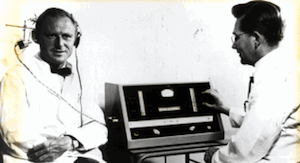After seeing a movie over the holiday season, I was chased out of the movie theatre…. NEVER TAKE PICTURES IN THE MEN’S WASHROOM!
So, here is the story…
It was a pretty good movie and I used the washroom facilities afterwards. While drying my hands I noticed a sign covered in plastic above the hot air blower and that’s when the trouble started. The picture below says it all… I apologize for the shine over some of the writing, but when trying to take a picture in a public washroom, one needs to be circumspect. I didn’t have time to set it up to look pretty and get rid of the sheen over some of the writing. The sign says that the movies in this theatre complex had “lowered volumes…” making this a friendlier environment.
At about this time I also fiddled with the phone to open up my sound level meter app to see how loud the air blower was at the level of my face – it was 99 dBA with a peak sound level of 118 dB SPL.
Shortly after, I was being chased around the theatre parking lot by some well-meaning, but misdirected, fathers.
I hurriedly explained about the significance of the peak being almost 20 dB above the RMS value of 99 dBA but this did not deter them. I then switched tactics and then went on to explain about how the movie theatres (and TV commercials) use compression to make their commercials before the movie, louder. I explained that with the judicious use of compression, the peaks can be reduced to within several dB of the RMS or average of the signal, and then the master volume could be increased to increase the peaks to their pre-compressed level. In this way, the average loudness (as given by the RMS of the signal) would be just below the maximum peak level of the sound.
This slowed them down somewhat…
As I dodged between cars trying to get away, I told them that many regulations only specify the peak level and not the RMS or average level, so that the broadcast level of the commercials could be as high as they could be, up to the level of the peak. Of course, the sound quality was not the best, but somewhere along the line, the advertisers clued in to the fact that louder was better, as long as they don’t exceed the broadcast regulations.
I managed to outwit the well-meaning fathers and eventually escaped down an alley way with my identity under one arm and my sound level meter app under the other…. I think that next time, I will try a different cinema complex, or perhaps wear a wig!









Good story!
I use Audio Tools, on the dBA setting, which was recommended by an acoustician. Do you have any suggestions on the various apps? And how accurate do you think they are (how big are the error bars)?
Which sound level meter app is that?
Actually I no longer use that sound level meter app. It did show the difference between RMS and peak (which can be useful if you are interested in crest factors) but lately, as a result of some recent research performed at Ryerson University the one I now use is SLA Lite (Sound Level Analyzer Lite rev 2.2). This is a free app. The article that compared the various apps (and of course this is an ever changing landscape) will be published in http://www.CanadianAudiologist.ca and will go live on the PM of Thursday Jan. 19 (issue 1, volume 4). This is the official e-journal of the Canadian Academy of Audiology and is free for download. (And I am the editor in chief and chief bottle washer).
Thanks, Marshall
GREAT information!
Now if I could just stop laughing. Never have I so enjoyed reading about RMS values and pre-compressed dB levels.
Thank you!